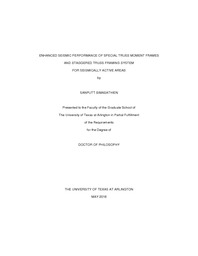
ATTENTION: The works hosted here are being migrated to a new repository that will consolidate resources, improve discoverability, and better show UTA's research impact on the global community. We will update authors as the migration progresses. Please see MavMatrix for more information.
Show simple item record
| dc.contributor.advisor | Chao, Shih-Ho | |
| dc.creator | Simasathien, Sanputt | |
| dc.date.accessioned | 2016-09-28T18:31:16Z | |
| dc.date.available | 2016-09-28T18:31:16Z | |
| dc.date.created | 2016-05 | |
| dc.date.issued | 2016-05-10 | |
| dc.date.submitted | May 2016 | |
| dc.identifier.uri | http://hdl.handle.net/10106/25917 | |
| dc.description.abstract | Due to their ability to achieve large column-free floor spaces, special truss moment frames (STMFs) and staggered truss frames (STFs) are unique valuable options for structural engineers. However, although STMFs and STFs offer a wide range of structural, architectural, and economical benefits, limited research data is available on the seismic performance of these systems.
STMF system is a relatively new type of steel framing system for use in high seismic areas. STMFs dissipate earthquake energy through ductile special segments located near the mid-span of the truss girders, while the other members outside the special segment, including truss members, columns, and girder-to-column connections, are designed to remain elastic. When an STMF is subjected to seismic forces, the induced shear force in the middle of the truss girder is resisted primarily by the chord members in the special segment. One of the major advantages of using the STMF system is that the truss girders can be economically used over longer spans, and greater overall structural stiffness can be achieved by using deeper girders. In addition, the open-webs can easily accommodate mechanical and electrical ductwork. As a consequence, this system offers a wide range of structural, architectural, and economical benefits due to their ability to achieve a large column-free floor. Due to the lack of continuing research to reflect the current practice in design and detailing on STMFs, the seismic performance research data of the system is limited. Substantial improvement in design methodology and confidence could be gained for STMFs by further research.
STF system was developed to achieve a more efficient structural framing system to resist wind loads and at the same time provide versatility of floor layout with large open areas. The result was an efficient steel framing system for mid- to high-rise buildings with low floor-to-floor heights and large column-free spaces that was simple to fabricate and erect. Because of the design flexibility, construction efficiency, and overall cost efficiencies, STF system has become a popular system in regions of low seismicity. Although STF system was originally developed for low seismic regions, the high lateral stiffness and light weight structural frames make this system attractive for use in high seismic regions. However, strong ground motions anticipated in regions of high seismicity significantly change the response of the STF system and necessitate system elements that are adequate in low-seismicity regions. Limited studies have been conducted on the behavior of STF system under strong earthquake ground motions. A key to the lateral-load resisting mechanism of STF system is the active participation of the floor diaphragms (typically consists of prestressed hollow-core planks) to transfer the inertial forces cumulating in a staggered manner across the height of the structure. The increasingly large diaphragm shear force in the lower stories brings concerns regarding the cyclic behavior of diaphragm-to-truss connections, local stress demand in the diaphragms under in-plane force and out-of-plane displacement. The stability of the system needs to be investigated if the trusses are designed to take inelastic action since the trusses serve as both the gravity and lateral-load resisting systems. | |
| dc.format.mimetype | application/pdf | |
| dc.language.iso | en_US | |
| dc.subject | Special truss moment frames | |
| dc.subject | Staggered truss frames | |
| dc.subject | Seismic design | |
| dc.subject | Structural steel | |
| dc.subject | Special segments | |
| dc.title | Enhanced Seismic Performance of Special Truss Moment Frames and Staggered Truss Framing System for Seismically Active Areas | |
| dc.type | Thesis | |
| dc.degree.department | Civil Engineering | |
| dc.degree.name | Doctor of Philosophy in Civil Engineering | |
| dc.date.updated | 2016-09-28T18:33:23Z | |
| thesis.degree.department | Civil Engineering | |
| thesis.degree.grantor | The University of Texas at Arlington | |
| thesis.degree.level | Doctoral | |
| thesis.degree.name | Doctor of Philosophy in Civil Engineering | |
| dc.type.material | text | |
| dc.creator.orcid | 0000-0002-8632-6583 | |
Files in this item
- Name:
- SIMASATHIEN-DISSERTATION-2016.pdf
- Size:
- 37.05Mb
- Format:
- PDF
This item appears in the following Collection(s)
Show simple item record


